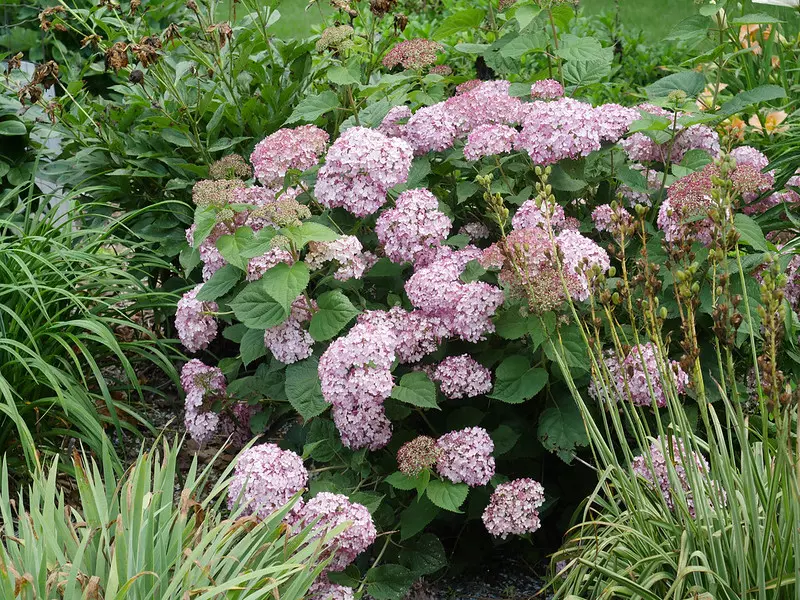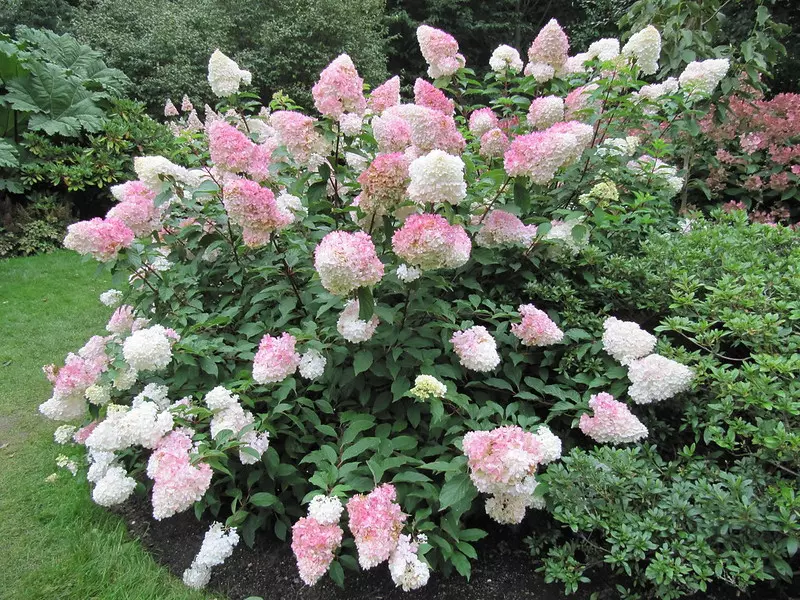Table of Contents
Hydrangea paniculata, also known as panicle hydrangea, is a favourite among UK gardeners due to its hardiness, vibrant blooms, and versatility. Whether you’re designing a small garden or a large landscape, these top 10 varieties are guaranteed to impress.
1. Hydrangea paniculata 'Limelight'
Hydrangea paniculata 'Limelight' is a deciduous shrub renowned for its large, lime-green flower panicles that bloom from mid-summer to autumn. This variety has become a favourite among UK gardeners due to its striking appearance and robust nature.
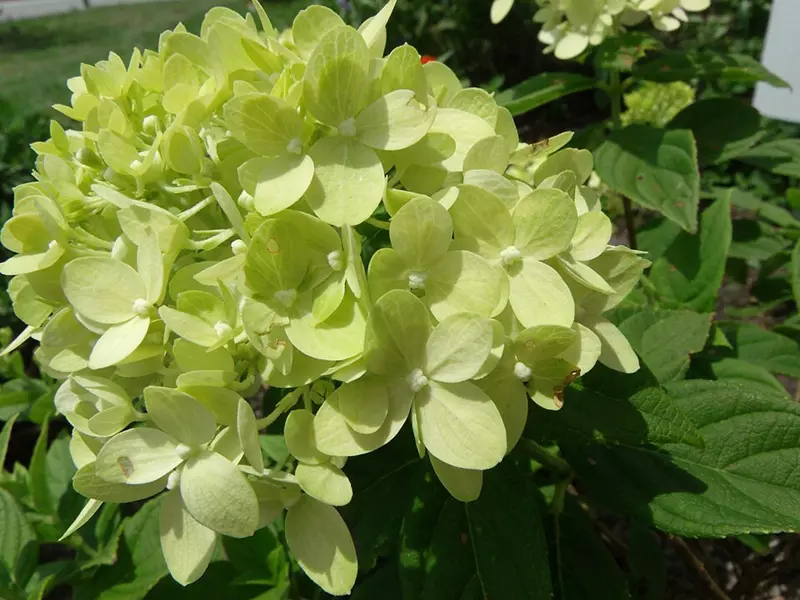 Mini limelight hydrangea - Source: By MChance666 - Own work, CC BY-SA 4.0, Link
Mini limelight hydrangea - Source: By MChance666 - Own work, CC BY-SA 4.0, Link
Plant Characteristics
- Height and Spread: Typically reaches 1.5 to 2.5 metres in height and spread.
- Foliage: Dark green leaves that provide a lush backdrop to the vibrant blooms.
- Flowers: Dense, cone-shaped panicles of sterile florets that open pale lime-green, gradually becoming creamy-white, and often developing a pink flush as they mature.
- Hardiness: Fully hardy in the UK climate.
Preferred Growing Conditions
- Soil: Thrives in moist but well-drained soils, including clay, loam, and sand. Tolerates a range of pH levels from acid to alkaline.
- Light: Prefers full sun to partial shade. In sunnier positions, ensure the soil remains reliably moist.
- Moisture: Requires consistent moisture, especially during dry periods.
Planting and Care
- Planting Time: Best planted in spring or autumn when the soil is warm and workable.
- Watering: Water regularly during the first growing season to establish a deep, extensive root system.
- Mulching: Apply a layer of organic mulch around the base to conserve moisture and regulate soil temperature.
- Feeding: Incorporate well-rotted manure or compost into the planting hole. Apply a balanced fertiliser in early spring.
Pruning
Prune in late winter or early spring to encourage vigorous growth and prolific flowering. Cut back the previous year's growth to a pair of healthy buds. This practice maintains the shrub's shape and promotes larger flower heads.
Common Pests and Diseases
'Limelight' is generally resistant to pests and diseases. However, it can occasionally be affected by:
- Aphids: Small sap-sucking insects that can cause distorted growth.
- Powdery Mildew: A fungal disease that creates a white, powdery coating on leaves.
Regular monitoring and appropriate cultural practices, such as proper spacing and watering at the base, can help prevent these issues.
Landscaping Uses
'Limelight' is versatile in garden design and can be used for:
- Specimen Planting: As a focal point in mixed borders or lawns.
- Hedging: Planted in a row to create informal hedges.
- Containers: Grown in large pots for patios and terraces.
- Cut Flowers: The blooms are excellent for fresh and dried floral arrangements.
Hydrangea paniculata 'Limelight' offers year-round interest with its vibrant blooms and attractive foliage. Its adaptability and ease of care make it a valuable addition to UK gardens, providing both aesthetic appeal and functional versatility.
2. Hydrangea paniculata 'Vanille Fraise'
Hydrangea paniculata 'Vanille Fraise', commonly known as 'Vanilla Strawberry', is a deciduous shrub celebrated for its large, conical flower panicles that undergo a stunning colour transformation from creamy white to deep pink. This variety has gained popularity among UK gardeners for its prolonged blooming period and striking visual appeal.
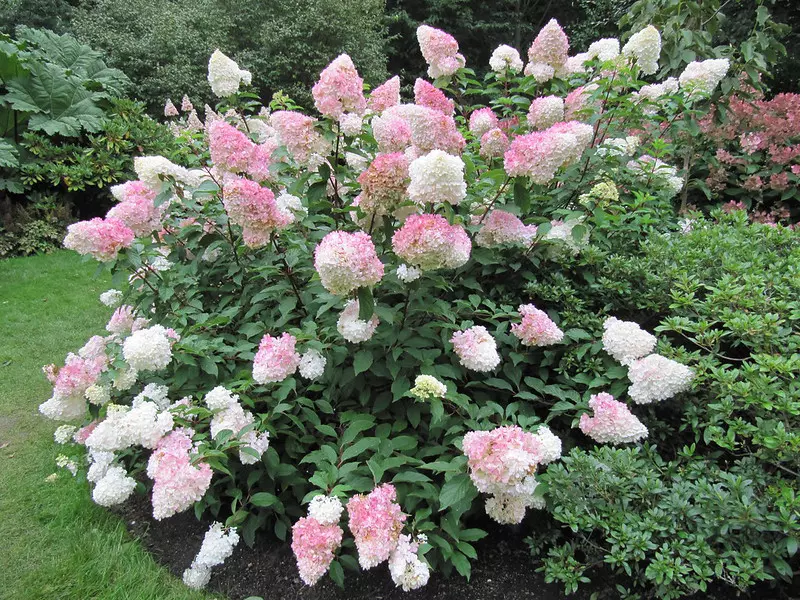 Hydrangea arborescens 'Vanille Fraise' - Source: flickr.com; Author: Leonora (Ellie) Enking; License: CC BY-SA 2.0
Hydrangea arborescens 'Vanille Fraise' - Source: flickr.com; Author: Leonora (Ellie) Enking; License: CC BY-SA 2.0
Plant Characteristics
- Height and Spread: Reaches approximately 2 metres in height and 1.5 metres in spread, making it suitable for various garden sizes.
- Foliage: Features mid-green, ovate leaves that provide an attractive backdrop to the vibrant blooms.
- Flowers: Produces large, pyramid-shaped panicles of sterile florets that open creamy white in mid-summer, gradually turning pink and eventually deepening to a rich rose-red by autumn.
- Hardiness: Fully hardy across the UK and northern Europe, tolerating temperatures down to -20°C.
Preferred Growing Conditions
- Soil: Prefers moist but well-drained, moderately fertile soils. It adapts to a range of soil types, including clay, loam, and sand, with a pH that can be acid, neutral, or alkaline.
- Light: Thrives in full sun to partial shade. In hotter regions, providing some afternoon shade can help prevent leaf scorch and maintain flower colour.
- Moisture: Requires consistent moisture, especially during dry spells, to support healthy growth and abundant flowering.
Planting and Care
- Planting Time: The ideal times for planting are late spring or early autumn, allowing the shrub to establish roots before extreme temperatures.
- Watering: Water thoroughly after planting and maintain regular watering during dry periods, particularly in the first year.
- Mulching: Apply a 5-7.5 cm layer of organic mulch, such as compost or well-rotted manure, around the base to conserve moisture and regulate soil temperature.
- Feeding: Incorporate a balanced, slow-release fertiliser in early spring to promote vigorous growth and prolific flowering.
Pruning
Prune 'Vanille Fraise' in late winter or early spring while the plant is dormant. Cut back the previous season's growth to a pair of healthy buds above the woody framework. This encourages strong new shoots and enhances the size and quality of the flower panicles.
Common Pests and Diseases
'Vanille Fraise' is generally resilient but may occasionally encounter:
- Powdery Mildew: A fungal disease causing a white, powdery coating on leaves. Ensuring good air circulation and avoiding overhead watering can help prevent it.
- Aphids: Small insects that feed on sap, leading to distorted growth. Regular monitoring and encouraging natural predators can keep populations in check.
Landscaping Uses
'Vanille Fraise' offers versatility in garden design:
- Specimen Plant: Serves as a focal point in mixed borders or as a standalone feature.
- Hedging: Forms informal hedges that provide seasonal interest.
- Containers: Suitable for large pots on patios or terraces, adding vertical interest.
- Cut Flowers: The long-lasting blooms are excellent for fresh and dried arrangements.
Hydrangea paniculata 'Vanille Fraise' is a captivating addition to UK gardens, offering dynamic colour changes and extended blooming periods. Its adaptability and ease of care make it a valuable choice for gardeners seeking both beauty and resilience.
3. Hydrangea paniculata 'Pinky Winky'
Hydrangea paniculata 'Pinky Winky' is a deciduous shrub celebrated for its unique two-tone flower panicles that transition from white to pink as they mature. This variety has gained popularity among UK gardeners for its striking appearance and robust nature.
Plant Characteristics
- Height and Spread: Typically reaches 1.4 metres in height and 1.6 metres in spread, making it suitable for various garden sizes.
- Foliage: Features yellow-green leaves that provide an attractive backdrop to the vibrant blooms.
- Flowers: Produces dense, conical panicles of sterile florets that open lime green, then pale to white, turning deep pink at maturity, creating a striking two-tone effect.
- Hardiness: Fully hardy across the UK, tolerating a range of climatic conditions.
Preferred Growing Conditions
- Soil: Prefers moist but well-drained, moderately fertile soils. It adapts to a range of soil types, including clay, loam, and sand, with a pH that can be acid, neutral, or alkaline.
- Light: Thrives in full sun to partial shade. In sunnier positions, ensure the soil remains reliably moist.
- Moisture: Requires consistent moisture, especially during dry periods, to support healthy growth and abundant flowering.
Planting and Care
- Planting Time: The ideal times for planting are late spring or early autumn, allowing the shrub to establish roots before extreme temperatures.
- Watering: Water thoroughly after planting and maintain regular watering during dry periods, particularly in the first year.
- Mulching: Apply a 5-7.5 cm layer of organic mulch, such as compost or well-rotted manure, around the base to conserve moisture and regulate soil temperature.
- Feeding: Incorporate a balanced, slow-release fertiliser in early spring to promote vigorous growth and prolific flowering.
Pruning
Prune 'Pinky Winky' in late winter or early spring while the plant is dormant. Cut back the previous season's growth to a pair of healthy buds above the woody framework. This encourages strong new shoots and enhances the size and quality of the flower panicles.
Common Pests and Diseases
'Pinky Winky' is generally resilient but may occasionally encounter:
- Powdery Mildew: A fungal disease causing a white, powdery coating on leaves. Ensuring good air circulation and avoiding overhead watering can help prevent it.
- Aphids: Small insects that feed on sap, leading to distorted growth. Regular monitoring and encouraging natural predators can keep populations in check.
Landscaping Uses
'Pinky Winky' offers versatility in garden design:
- Specimen Plant: Serves as a focal point in mixed borders or as a standalone feature.
- Hedging: Forms informal hedges that provide seasonal interest.
- Containers: Suitable for large pots on patios or terraces, adding vertical interest.
- Cut Flowers: The long-lasting blooms are excellent for fresh and dried arrangements.
Hydrangea paniculata 'Pinky Winky' is a captivating addition to UK gardens, offering dynamic colour changes and extended blooming periods. Its adaptability and ease of care make it a valuable choice for gardeners seeking both beauty and resilience.
4. Hydrangea paniculata 'Phantom'
Hydrangea paniculata 'Phantom' is a deciduous shrub renowned for its exceptionally large, dense flower panicles that transition from creamy white to pink as they mature. This variety has become a favourite among UK gardeners due to its striking appearance and robust nature.
Plant Characteristics
- Height and Spread: Typically reaches 2 to 2.5 metres in height and spread, making it suitable for various garden sizes.
- Foliage: Features strong, stiff green stems supporting large, very dense panicles of creamy-white fertile florets, and white sterile florets with some lime green tints, flushing pink at maturity, during summer and autumn.
- Flowers: Produces large, dense, conical panicles of creamy-white flowers that gradually turn pink as they mature, creating a striking two-tone effect.
- Hardiness: Fully hardy across the UK, tolerating a range of climatic conditions.
Preferred Growing Conditions
- Soil: Prefers moist but well-drained, moderately fertile soils. It adapts to a range of soil types, including clay, loam, and sand, with a pH that can be acid, neutral, or alkaline.
- Light: Thrives in full sun to partial shade. In sunnier positions, ensure the soil remains reliably moist.
- Moisture: Requires consistent moisture, especially during dry periods, to support healthy growth and abundant flowering.
Planting and Care
- Planting Time: The ideal times for planting are late spring or early autumn, allowing the shrub to establish roots before extreme temperatures.
- Watering: Water thoroughly after planting and maintain regular watering during dry periods, particularly in the first year.
- Mulching: Apply a 5-7.5 cm layer of organic mulch, such as compost or well-rotted manure, around the base to conserve moisture and regulate soil temperature.
- Feeding: Incorporate a balanced, slow-release fertiliser in early spring to promote vigorous growth and prolific flowering.
Pruning
Prune 'Phantom' in late winter or early spring while the plant is dormant. Cut back the previous season's growth to a pair of healthy buds above the woody framework. This encourages strong new shoots and enhances the size and quality of the flower panicles.
Common Pests and Diseases
'Phantom' is generally resilient but may occasionally encounter:
- Powdery Mildew: A fungal disease causing a white, powdery coating on leaves. Ensuring good air circulation and avoiding overhead watering can help prevent it.
- Aphids: Small insects that feed on sap, leading to distorted growth. Regular monitoring and encouraging natural predators can keep populations in check.
Landscaping Uses
'Phantom' offers versatility in garden design:
- Specimen Plant: Serves as a focal point in mixed borders or as a standalone feature.
- Hedging: Forms informal hedges that provide seasonal interest.
- Containers: Suitable for large pots on patios or terraces, adding vertical interest.
- Cut Flowers: The long-lasting blooms are excellent for fresh and dried arrangements.
Hydrangea paniculata 'Phantom' is a captivating addition to UK gardens, offering dynamic colour changes and extended blooming periods. Its adaptability and ease of care make it a valuable choice for gardeners seeking both beauty and resilience.
5. Hydrangea paniculata 'Little Lime'
Hydrangea paniculata 'Little Lime' is a compact deciduous shrub renowned for its lime-green flower panicles that gracefully transition to pink as they mature. This variety has gained popularity among UK gardeners for its manageable size and vibrant blooms.
Plant Characteristics
- Height and Spread: Reaches approximately 1 to 1.5 metres in height and spread, making it suitable for smaller gardens and container planting.
- Foliage: Features pointed, ovate, dark-green leaves that turn yellow in autumn, providing seasonal interest.
- Flowers: Produces large panicles of lime-green flowers that fade to cream and then flush pink with age, lasting from July through to September.
- Hardiness: Fully hardy across the UK, tolerating a range of climatic conditions.
Preferred Growing Conditions
- Soil: Prefers moist but well-drained, moderately fertile soils. It adapts to a range of soil types, including clay, loam, and sand, with a pH that can be acid, neutral, or alkaline.
- Light: Thrives in full sun to partial shade. In sunnier positions, ensure the soil remains reliably moist.
- Moisture: Requires consistent moisture, especially during dry periods, to support healthy growth and abundant flowering.
Planting and Care
- Planting Time: The ideal times for planting are late spring or early autumn, allowing the shrub to establish roots before extreme temperatures.
- Watering: Water thoroughly after planting and maintain regular watering during dry periods, particularly in the first year.
- Mulching: Apply a 5-7.5 cm layer of organic mulch, such as compost or well-rotted manure, around the base to conserve moisture and regulate soil temperature.
- Feeding: Incorporate a balanced, slow-release fertiliser in early spring to promote vigorous growth and prolific flowering.
Pruning
Prune 'Little Lime' in late winter or early spring while the plant is dormant. Cut back the previous season's growth to a pair of healthy buds above the woody framework. This encourages strong new shoots and enhances the size and quality of the flower panicles.
Common Pests and Diseases
'Little Lime' is generally resilient but may occasionally encounter:
- Powdery Mildew: A fungal disease causing a white, powdery coating on leaves. Ensuring good air circulation and avoiding overhead watering can help prevent it.
- Aphids: Small insects that feed on sap, leading to distorted growth. Regular monitoring and encouraging natural predators can keep populations in check.
Landscaping Uses
'Little Lime' offers versatility in garden design:
- Specimen Plant: Serves as a focal point in mixed borders or as a standalone feature.
- Hedging: Forms informal hedges that provide seasonal interest.
- Containers: Suitable for large pots on patios or terraces, adding vertical interest.
- Cut Flowers: The long-lasting blooms are excellent for fresh and dried arrangements.
Hydrangea paniculata 'Little Lime' is a captivating addition to UK gardens, offering dynamic colour changes and extended blooming periods. Its adaptability and ease of care make it a valuable choice for gardeners seeking both beauty and resilience.
6. Hydrangea paniculata 'Bobo'
Hydrangea paniculata 'Bobo' is a dwarf deciduous shrub celebrated for its prolific display of large, conical white flowers that gradually blush pink as autumn approaches. Its compact size and abundant blooms make it an excellent choice for UK gardens, particularly where space is limited.
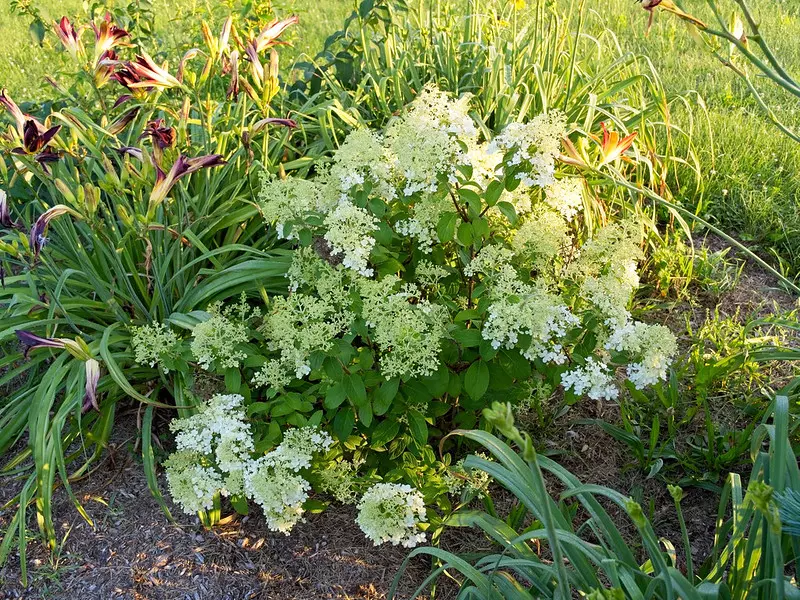 Hydrangea arborescens 'Bobo' - Source: flickr.com; Author: F. D. Richards; License: CC BY-SA 2.0
Hydrangea arborescens 'Bobo' - Source: flickr.com; Author: F. D. Richards; License: CC BY-SA 2.0
Plant Characteristics
- Height and Spread: Reaches up to 90 cm in height and 120 cm in spread, making it ideal for small gardens and container planting.
- Foliage: Features lush green leaves that provide an attractive backdrop to the vibrant blooms.
- Flowers: Produces large, conical panicles of pure white flowers in late summer, which gradually take on a pale pink hue as the season progresses.
- Hardiness: Fully hardy across the UK, capable of withstanding typical British winters.
Preferred Growing Conditions
- Soil: Thrives in moist but well-drained, moderately fertile soils. It adapts well to various soil types, including clay, loam, and sand, with a pH that can be acid, neutral, or alkaline.
- Light: Prefers full sun to partial shade. In sunnier positions, ensure the soil remains reliably moist to support healthy growth.
- Moisture: Requires consistent moisture, especially during dry periods, to promote vigorous growth and abundant flowering.
Planting and Care
- Planting Time: The optimal times for planting are late spring or early autumn, allowing the shrub to establish roots before the onset of extreme temperatures.
- Watering: Water thoroughly after planting and maintain regular watering during dry spells, particularly in the first year to establish a strong root system.
- Mulching: Apply a 5-7.5 cm layer of organic mulch, such as compost or well-rotted manure, around the base to conserve moisture and regulate soil temperature.
- Feeding: Incorporate a balanced, slow-release fertiliser in early spring to encourage vigorous growth and prolific flowering.
Pruning
Prune 'Bobo' in late winter or early spring while the plant is dormant. Cut back the previous season's growth to a pair of healthy buds above the woody framework. This practice encourages strong new shoots and enhances the size and quality of the flower panicles.
Common Pests and Diseases
'Bobo' is generally resilient but may occasionally encounter:
- Powdery Mildew: A fungal disease that manifests as a white, powdery coating on leaves. Ensuring good air circulation and avoiding overhead watering can help prevent its occurrence.
- Aphids: Small insects that feed on plant sap, leading to distorted growth. Regular monitoring and encouraging natural predators can help keep their populations in check.
Landscaping Uses
'Bobo' offers versatility in garden design:
- Specimen Plant: Serves as a focal point in mixed borders or as a standalone feature.
- Hedging: Forms informal hedges that provide seasonal interest.
- Containers: Suitable for large pots on patios or terraces, adding vertical interest to small spaces.
- Cut Flowers: The long-lasting blooms are excellent for both fresh and dried arrangements.
Hydrangea paniculata 'Bobo' is a captivating addition to UK gardens, offering dynamic colour changes and an extended blooming period. Its compact size, adaptability, and ease of care make it a valuable choice for gardeners seeking both beauty and resilience in limited spaces.
7. Hydrangea paniculata 'Great Star'
Hydrangea paniculata 'Great Star' is a vigorous deciduous shrub celebrated for its large, star-shaped white flowers that bloom from mid-summer into early autumn. This variety has gained popularity among UK gardeners for its unique floral display and robust growth habit.
Plant Characteristics
- Height and Spread: Typically reaches 1.5 to 2.5 metres in height and 1 to 1.5 metres in spread, making it suitable for various garden sizes.
- Foliage: Features bright green ovate leaves that provide an attractive backdrop to the striking blooms.
- Flowers: Produces large, rounded to cone-shaped flower heads composed of tiny fertile flowers and large, star-shaped sterile flowers with narrow, slightly twisted petals. The flowers open white and take on a pink tint as they mature, with flower heads reaching up to 50 cm long.
- Hardiness: Fully hardy across the UK, capable of withstanding typical British winters.
Preferred Growing Conditions
- Soil: Prefers moist but well-drained, moderately fertile soils. It adapts well to various soil types, including clay, loam, and sand, with a pH that can be acid, neutral, or alkaline.
- Light: Thrives in full sun to partial shade. In sunnier positions, ensure the soil remains reliably moist to support healthy growth.
- Moisture: Requires consistent moisture, especially during dry periods, to promote vigorous growth and abundant flowering.
Planting and Care
- Planting Time: The optimal times for planting are late spring or early autumn, allowing the shrub to establish roots before the onset of extreme temperatures.
- Watering: Water thoroughly after planting and maintain regular watering during dry spells, particularly in the first year to establish a strong root system.
- Mulching: Apply a 5-7.5 cm layer of organic mulch, such as compost or well-rotted manure, around the base to conserve moisture and regulate soil temperature.
- Feeding: Incorporate a balanced, slow-release fertiliser in early spring to encourage vigorous growth and prolific flowering.
Pruning
Prune 'Great Star' in late winter or early spring while the plant is dormant. Cut back the previous season's growth to a pair of healthy buds above the woody framework. This practice encourages strong new shoots and enhances the size and quality of the flower panicles.
Common Pests and Diseases
'Great Star' is generally resilient but may occasionally encounter:
- Powdery Mildew: A fungal disease that manifests as a white, powdery coating on leaves. Ensuring good air circulation and avoiding overhead watering can help prevent its occurrence.
- Aphids: Small insects that feed on plant sap, leading to distorted growth. Regular monitoring and encouraging natural predators can help keep their populations in check.
Landscaping Uses
'Great Star' offers versatility in garden design:
- Specimen Plant: Serves as a focal point in mixed borders or as a standalone feature.
- Hedging: Forms informal hedges that provide seasonal interest.
- Containers: Suitable for large pots on patios or terraces, adding vertical interest to small spaces.
- Cut Flowers: The long-lasting blooms are excellent for both fresh and dried arrangements.
Hydrangea paniculata 'Great Star' is a captivating addition to UK gardens, offering dynamic colour changes and an extended blooming period. Its unique star-shaped flowers, adaptability, and ease of care make it a valuable choice for gardeners seeking both beauty and resilience.
8. Hydrangea paniculata 'Silver Dollar'
Hydrangea paniculata 'Silver Dollar' is a compact deciduous shrub renowned for its dense, creamy-white flower panicles that gradually acquire a pink flush as they mature. This variety is ideal for small gardens and adds a touch of elegance to any landscape.
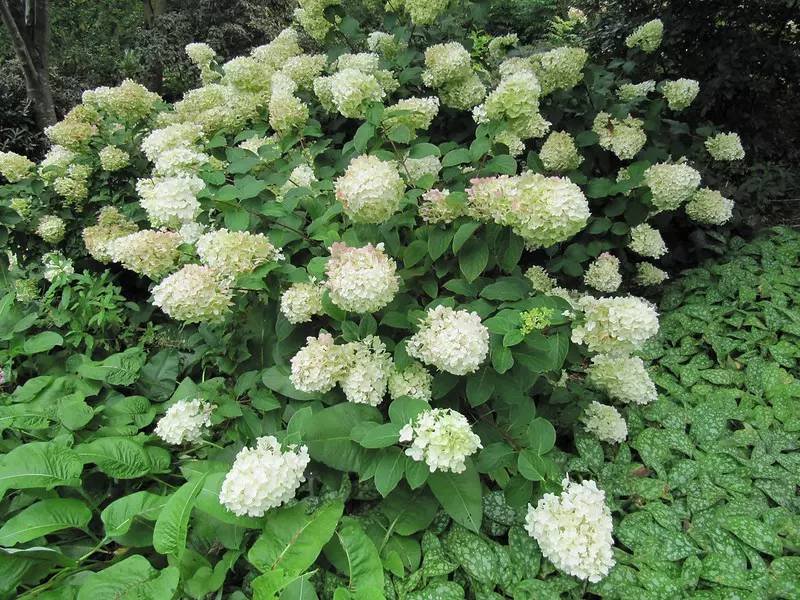 Hydrangea arborescens 'Silver Dollar' - Source: flickr.com; Author: Leonora (Ellie) Enking; License: CC BY-SA 2.0
Hydrangea arborescens 'Silver Dollar' - Source: flickr.com; Author: Leonora (Ellie) Enking; License: CC BY-SA 2.0
Plant Characteristics
- Height and Spread: Reaches approximately 1 to 1.5 metres in height and spread, making it suitable for limited spaces.
- Foliage: Features dark green, ovate leaves that provide a lush backdrop to the striking blooms.
- Flowers: Produces very dense, rounded, broadly conical flower panicles composed mainly of sterile florets, which open creamy-white and become pink-flushed as they age.
- Flowering Period: Blooms from August to September, offering late-season interest.
- Hardiness: Fully hardy across the UK, tolerating typical British winters.
Preferred Growing Conditions
- Soil: Prefers moist but well-drained, moderately fertile, humus-rich soils. It adapts to various soil types, including clay, loam, and sand, with a pH that can be acid, neutral, or alkaline.
- Light: Thrives in full sun or partial shade. In sunnier positions, ensure the soil remains reliably moist to support healthy growth.
- Moisture: Requires consistent moisture, especially during dry periods, to promote vigorous growth and abundant flowering.
Planting and Care
- Planting Time: The optimal times for planting are late spring or early autumn, allowing the shrub to establish roots before the onset of extreme temperatures.
- Watering: Water thoroughly after planting and maintain regular watering during dry spells, particularly in the first year to establish a strong root system.
- Mulching: Apply a 5-7.5 cm layer of organic mulch, such as compost or well-rotted manure, around the base to conserve moisture and regulate soil temperature.
- Feeding: Incorporate a balanced, slow-release fertiliser in early spring to encourage vigorous growth and prolific flowering.
Pruning
Prune 'Silver Dollar' in late winter or early spring while the plant is dormant. Cut back the previous season's growth to a pair of healthy buds above the woody framework. This practice encourages strong new shoots and enhances the size and quality of the flower panicles.
Common Pests and Diseases
'Silver Dollar' is generally resilient but may occasionally encounter:
- Powdery Mildew: A fungal disease that manifests as a white, powdery coating on leaves. Ensuring good air circulation and avoiding overhead watering can help prevent its occurrence.
- Aphids: Small insects that feed on plant sap, leading to distorted growth. Regular monitoring and encouraging natural predators can help keep their populations in check.
Landscaping Uses
'Silver Dollar' offers versatility in garden design:
- Specimen Plant: Serves as a focal point in mixed borders or as a standalone feature.
- Hedging: Forms informal hedges that provide seasonal interest.
- Containers: Suitable for large pots on patios or terraces, adding vertical interest to small spaces.
- Cut Flowers: The long-lasting blooms are excellent for both fresh and dried arrangements.
Hydrangea paniculata 'Silver Dollar' is a captivating addition to UK gardens, offering dynamic colour changes and an extended blooming period. Its compact size, adaptability, and ease of care make it a valuable choice for gardeners seeking both beauty and resilience.
9. Hydrangea paniculata 'Kyushu'
Hydrangea paniculata 'Kyushu' is a vigorous deciduous shrub renowned for its upright growth habit and elegant, conical clusters of creamy-white flowers that bloom from late summer to mid-autumn. Its slightly glossy, mid to dark green leaves provide an attractive backdrop to the floral display, making it a favoured choice among UK gardeners.
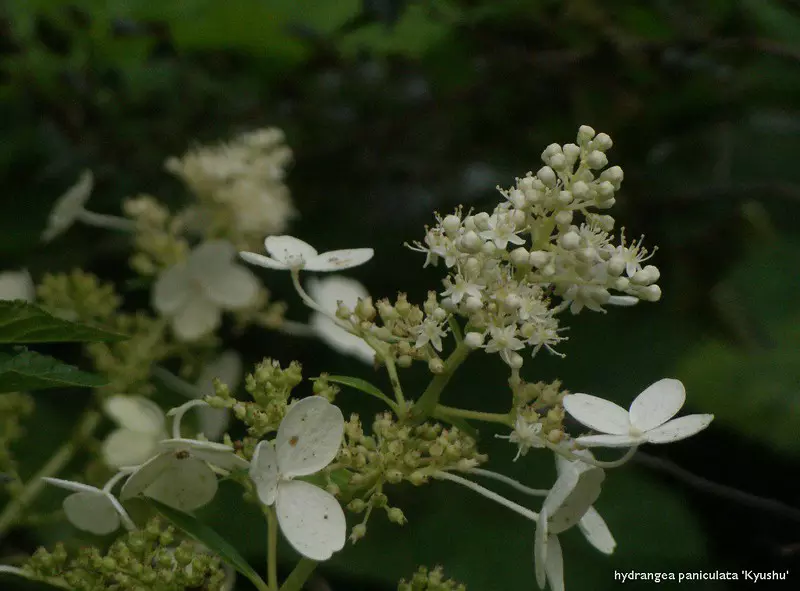 Hydrangea arborescens 'Kyushu' - Source: flickr.com; Author: Brigitte Rieser; License: CC BY-NC-ND 2.0
Hydrangea arborescens 'Kyushu' - Source: flickr.com; Author: Brigitte Rieser; License: CC BY-NC-ND 2.0
Plant Characteristics
- Height and Spread: Typically reaches 1.5 to 2.5 metres in height and 1 to 1.5 metres in spread, making it suitable for various garden sizes.
- Foliage: Features slightly glossy, mid to dark green leaves that are ovate with serrated edges, providing a lush and vibrant appearance.
- Flowers: Produces slender, conical flowerheads composed of numerous creamy-white florets. These blooms are lightly fragrant and attract pollinators such as bees and butterflies.
- Flowering Period: Blooms from late summer to mid-autumn, offering extended seasonal interest.
- Hardiness: Fully hardy across the UK, capable of withstanding typical British winters.
Preferred Growing Conditions
- Soil: Prefers moist but well-drained, moderately fertile soils. It adapts well to various soil types, including clay, loam, and sand, with a pH that can be acid, neutral, or alkaline.
- Light: Thrives in full sun to partial shade. In sunnier positions, ensure the soil remains reliably moist to support healthy growth.
- Moisture: Requires consistent moisture, especially during dry periods, to promote vigorous growth and abundant flowering.
Planting and Care
- Planting Time: The optimal times for planting are late spring or early autumn, allowing the shrub to establish roots before the onset of extreme temperatures.
- Watering: Water thoroughly after planting and maintain regular watering during dry spells, particularly in the first year to establish a strong root system.
- Mulching: Apply a 5-7.5 cm layer of organic mulch, such as compost or well-rotted manure, around the base to conserve moisture and regulate soil temperature.
- Feeding: Incorporate a balanced, slow-release fertiliser in early spring to encourage vigorous growth and prolific flowering.
Pruning
Prune 'Kyushu' in late winter or early spring while the plant is dormant. Cut back the previous season's growth to a pair of healthy buds above the woody framework. This practice encourages strong new shoots and enhances the size and quality of the flower panicles.
Common Pests and Diseases
'Kyushu' is generally resilient but may occasionally encounter:
- Powdery Mildew: A fungal disease that manifests as a white, powdery coating on leaves. Ensuring good air circulation and avoiding overhead watering can help prevent its occurrence.
- Aphids: Small insects that feed on plant sap, leading to distorted growth. Regular monitoring and encouraging natural predators can help keep their populations in check.
Landscaping Uses
'Kyushu' offers versatility in garden design:
- Specimen Plant: Serves as a focal point in mixed borders or as a standalone feature.
- Hedging: Forms informal hedges that provide seasonal interest.
- Containers: Suitable for large pots on patios or terraces, adding vertical interest to small spaces.
- Cut Flowers: The long-lasting blooms are excellent for both fresh and dried arrangements.
Hydrangea paniculata 'Kyushu' is a captivating addition to UK gardens, offering dynamic colour changes and an extended blooming period. Its upright growth habit, adaptability, and ease of care make it a valuable choice for gardeners seeking both beauty and resilience.
10. Hydrangea paniculata 'Tardiva'
Hydrangea paniculata 'Tardiva' is a deciduous upright shrub renowned for its late-flowering nature, producing large, loosely packed panicles of creamy-white flowers from August into October. This variety is particularly valued for extending the hydrangea blooming season in UK gardens.
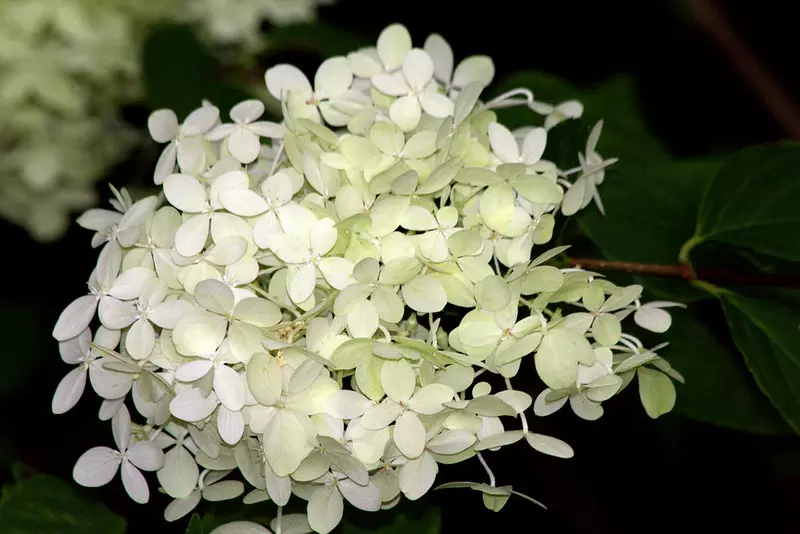 Hydrangea arborescens 'Tardiva' - Source: flickr.com; Author: manuel m. v.; License: CC BY 2.0
Hydrangea arborescens 'Tardiva' - Source: flickr.com; Author: manuel m. v.; License: CC BY 2.0
Plant Characteristics
- Height and Spread: Typically reaches 4 to 8 metres in height and 1.5 to 2.5 metres in spread, making it suitable for larger garden spaces.
- Foliage: Features dark green leaves that provide a lush backdrop to the striking blooms.
- Flowers: Produces large, loosely packed panicles of creamy-white flowers, which are later flowering than other H. paniculata cultivars.
- Flowering Period: Blooms from August into October, offering late-season interest.
- Hardiness: Fully hardy across the UK, capable of withstanding typical British winters.
Preferred Growing Conditions
- Soil: Prefers moist but well-drained, moderately fertile soils. It adapts well to various soil types, including clay, loam, and sand, with a pH that can be acid, neutral, or alkaline.
- Light: Thrives in full sun to partial shade. In sunnier positions, ensure the soil remains reliably moist to support healthy growth.
- Moisture: Requires consistent moisture, especially during dry periods, to promote vigorous growth and abundant flowering.
Planting and Care
- Planting Time: The optimal times for planting are late spring or early autumn, allowing the shrub to establish roots before the onset of extreme temperatures.
- Watering: Water thoroughly after planting and maintain regular watering during dry spells, particularly in the first year to establish a strong root system.
- Mulching: Apply a 5-7.5 cm layer of organic mulch, such as compost or well-rotted manure, around the base to conserve moisture and regulate soil temperature.
- Feeding: Incorporate a balanced, slow-release fertiliser in early spring to encourage vigorous growth and prolific flowering.
Pruning
Prune 'Tardiva' in late winter or early spring while the plant is dormant. Cut back the previous season's growth to a pair of healthy buds above the woody framework. This practice encourages strong new shoots and enhances the size and quality of the flower panicles.
Common Pests and Diseases
'Tardiva' is generally resilient but may occasionally encounter:
- Powdery Mildew: A fungal disease that manifests as a white, powdery coating on leaves. Ensuring good air circulation and avoiding overhead watering can help prevent its occurrence.
- Aphids: Small insects that feed on plant sap, leading to distorted growth. Regular monitoring and encouraging natural predators can help keep their populations in check.
Landscaping Uses
'Tardiva' offers versatility in garden design:
- Specimen Plant: Serves as a focal point in mixed borders or as a standalone feature.
- Hedging: Forms informal hedges that provide seasonal interest.
- Containers: Suitable for large pots on patios or terraces, adding vertical interest to small spaces.
- Cut Flowers: The long-lasting blooms are excellent for both fresh and dried arrangements.
Hydrangea paniculata 'Tardiva' is a captivating addition to UK gardens, offering dynamic colour changes and an extended blooming period. Its late-flowering nature, adaptability, and ease of care make it a valuable choice for gardeners seeking both beauty and resilience.
These top 10 Hydrangea paniculata varieties offer something for every garden style and size. Their versatility, stunning blooms, and low-maintenance care make them a must-have for any gardener. Whether you’re creating a cottage garden or a modern landscape, these hydrangeas will add timeless beauty to your outdoor space.
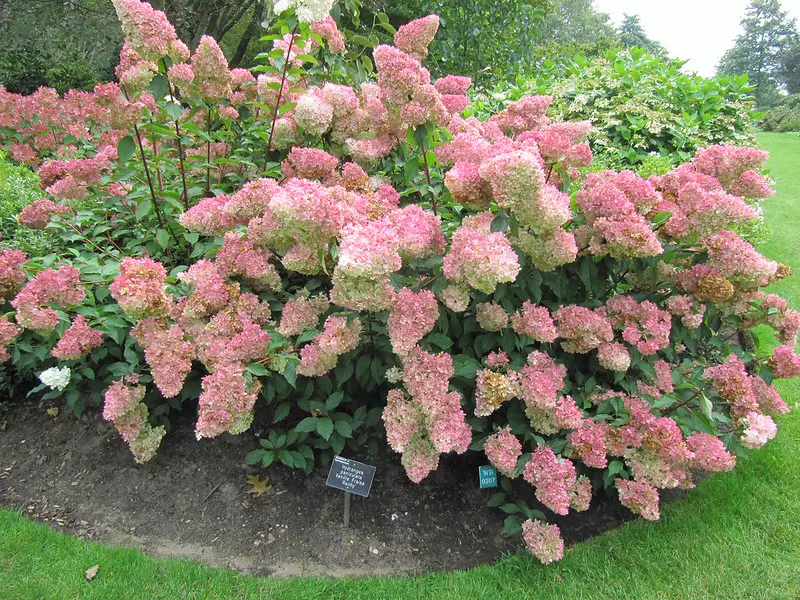
The Ultimate Guide to Hydrangea peniculata (Panicle Hydrangea)
A complete guide to Hydrangea peniculata, including planting, pruning, soil adjustments, eco-friendly pest management, propagation, and garden design ideas.
Read More
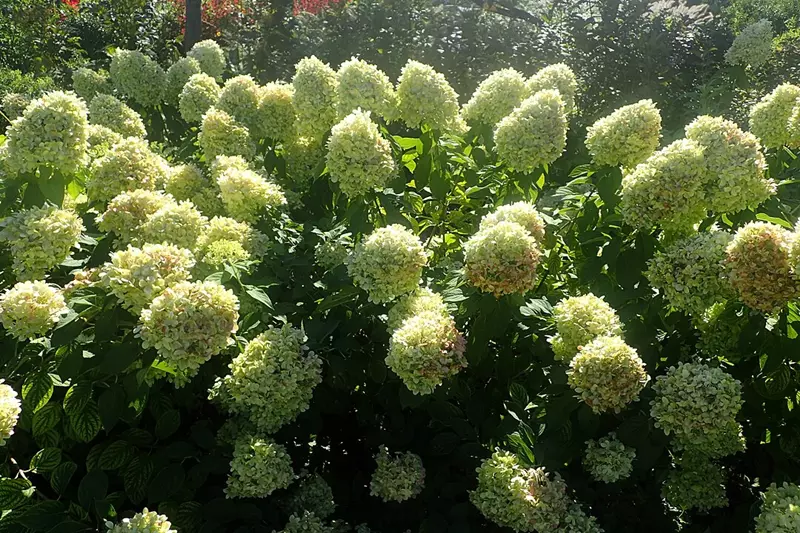
Hydrangea paniculata 'Limelight' - Care, Planting, and Pruning Guide
Discover how to grow and care for Hydrangea paniculata 'Limelight'. Learn about planting, maintenance, pruning, and the stunning beauty of this versatile shrub.
Read More
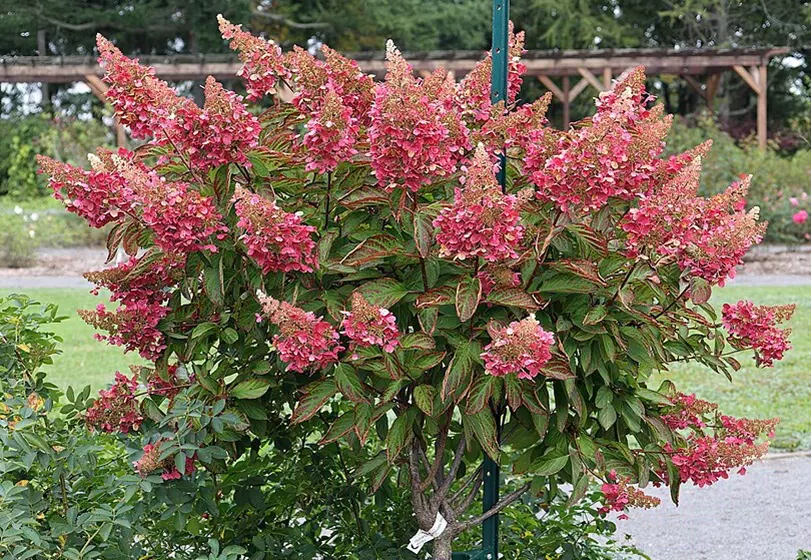
Hydrangea paniculata 'Pinky Winky': A Comprehensive Guide to Cultivation and Care
Discover the beauty and care tips for Hydrangea paniculata 'Pinky Winky'. Learn how to grow, prune, and use this stunning shrub in your garden.
Read More
About the Author

Richard Seres-Nagy is a passionate gardener with over 20 years of experience in hydrangea care. He founded Hydrangea Library to share expert advice, step-by-step guides, and practical tips for fellow gardening enthusiasts.
Read More











